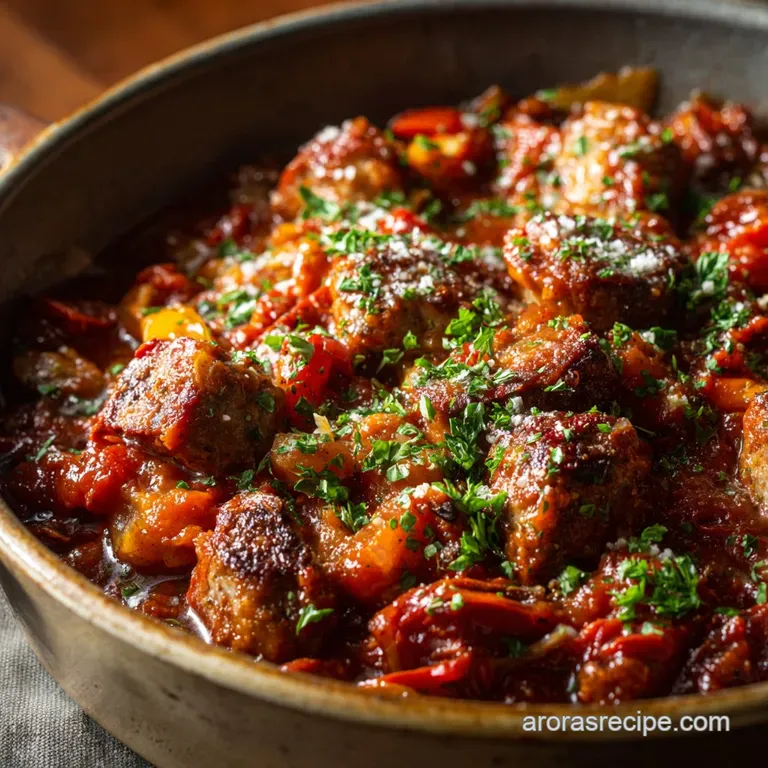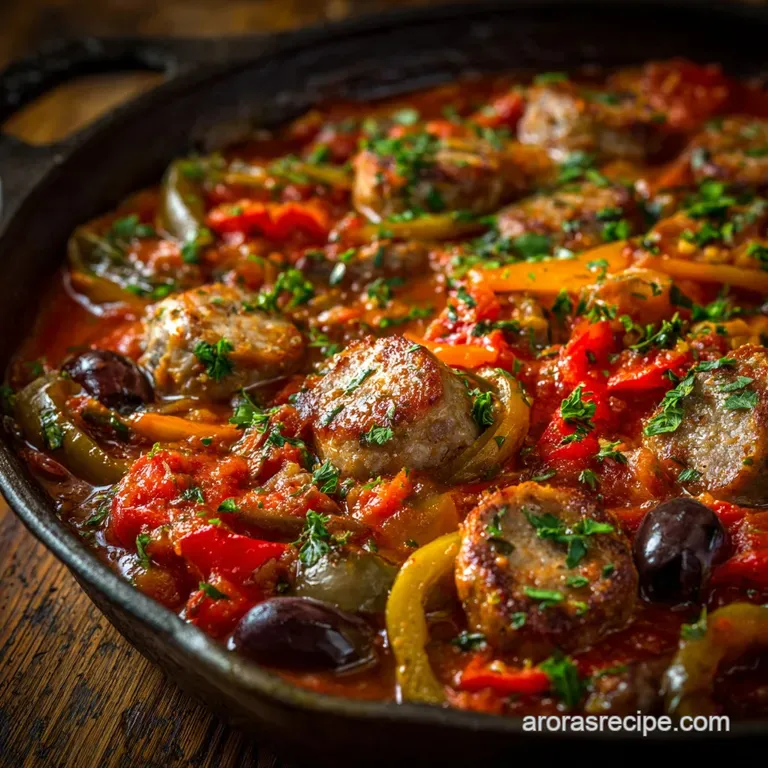Rustic Italian Sausage Cacciatore a Weeknight Feast

Why This Hunter's Stew Demands Italian Sausage
Defining the Classic Cacciatore Flavor Profile
Cacciatore translates simply to "hunter’s style," reflecting its rustic origins as a hearty meal cooked with whatever ingredients were available. The essential flavor profile is robustly savory, defined by the slow melding of tomatoes, earthy mushrooms, and aromatic peppers.
This Italian comfort food recipe is inherently satisfying, making it a perfect centerpiece for a family gathering.
The Simple Secret to Achieving Deep, Rustic Flavor
The intense depth required for a true Rustic Italian Sausage Cacciatore comes entirely from the initial browning stage. We rely on the natural fat rendered from the Italian sausage to create a foundation of rich, meaty flavor.
Searing the sausage aggressively builds caramelized bits, known as the fonds , directly onto the base of the cooking pot.
These brown remnants are the simple secret to a spectacular sausage cacciatore sauce. When deglazed later with wine, the caramelized flavor dissolves back into the liquid, lending an unmatched savory complexity that elevates the entire dish.
Essential Elements for the Perfect Sausage Cacciatore
The Minimalist Kitchen Tools Required

Fortunately, preparing a truly stunning sausage cacciatore recipe easy does not require specialized equipment. The most crucial item is a heavy bottomed vessel designed for long, even heat retention. A robust Dutch oven performs this task flawlessly, ensuring the stew simmers consistently without scorching.
You will also need standard prep tools:
- A large chef’s knife and cutting board.
- A sturdy wooden spoon for scraping the bottom of the pot.
- Basic measuring cups and spoons.
Choosing Your Sausage: Sweet, Hot, or Fennel?
When preparing this Cacciatore recipe weeknight masterpiece, the choice of sausage dictates the final taste profile. Sweet Italian sausage, which often contains fennel, provides a balanced, approachable flavor that appeals to most palates.
Using hot Italian sausage, however, introduces a pleasant warming heat that cuts through the richness of the tomato sauce beautifully.
For an authentic touch, ensure you use high-quality links or bulk sausage where the main flavoring comes from anise, black pepper, and sometimes paprika. Removing the casings allows the sausage to crumble slightly, helping it incorporate fully into the thick, savory sausage cacciatore sauce .
Selecting the Best Bell Peppers and Aromatics
Bell peppers are the heart of the vegetable base, and using a mix of red and yellow provides visual appeal and balanced sweetness. We pair these bright peppers with earthy cremini mushrooms and the essential sharp depth of yellow onion and fresh garlic.
Choosing firm, brightly colored peppers ensures they maintain some structure throughout the long simmer.
| Vegetable | Role in Cacciatore |
|---|---|
| Red Bell Pepper | Deep sweetness, mellowing during cooking. |
| Yellow Onion | Builds the base flavor when sautéed in fat. |
| Cremini Mushroom | Adds essential umami and meaty texture. |
Pantry Staples and Must Have Spice Notes
The quality of your canned tomatoes significantly impacts the final sausage cacciatore sauce . We rely on San Marzano style crushed tomatoes for their low acidity and superior natural sweetness, creating a richer depth than diced varieties.
Pairing the tomatoes with low-sodium chicken stock provides body without overwhelming the essential Italian flavors.
A crucial step for developing complex flavor is deglazing with a dry red wine, such as Chianti or Merlot. This acid cuts through the fat and concentrates the fruit notes, deepening the savory profile dramatically.
If avoiding alcohol, you can use extra stock mixed with a touch of balsamic vinegar for the necessary tang.
The dried herb blend focuses on classic Mediterranean notes: dried oregano, thyme, and one bay leaf. These specific seasonings are designed to infuse the stew with that familiar, warm, and highly aromatic quality we expect from Italian comfort food recipe preparation.
Skillet vs. Dutch Oven: Choosing Your Cooking Vessel
While a large skillet can handle the searing step, the long, slow simmer requires a more robust environment. The depth and heavy walls of the Dutch oven are specifically designed for braising, ensuring even heat distribution across the entire base.
This prevents scorching during the 45-minute cook time and yields ultra tender vegetables.
Chef's Note: For those making this a dedicated sausage cacciatore slow cooker meal, perform the initial browning of the sausage and aromatics on the stovetop first. Transferring those caramelized bits is key to achieving true depth of flavor in the final sauce.
Mastering the Art of Rustic Sausage Cacciatore
Rendering the Sausage and Building the Flavor Base
The first phase of this sausage cacciatore recipe involves aggressively browning the Italian sausage until deep caramelization forms. Whether you use whole links or rough one-inch meatballs, the goal is not to cook the meat through, but to build intense exterior flavor.
Use high heat and allow the meat to sit untouched for several minutes before flipping, encouraging a deep crust.
Once seared, remove the sausage with a slotted spoon, leaving behind the flavorful rendered fat and any sticking brown bits. This seasoned fat is now the base for cooking the vegetables, ensuring every layer of the dish carries the rich, savory taste of the meat.
Softening the 'Holy Trinity' of Peppers and Onions
Reduce the heat immediately after removing the meat to prevent the fat from smoking and burning the foundation. We then introduce the diced onions along with salt and pepper, which helps draw out moisture and softens the vegetable structure.
Once translucent, the garlic, bell peppers, and mushrooms join the pot, requiring about five to seven minutes to soften slightly before the liquids are added.
Deglazing the Pan and Introducing the Tomatoes
Deglazing is the pivotal step where the concentrated flavor from the seared sausage is recaptured. Pour the dry red wine directly into the hot pot, scraping vigorously to dissolve all the browned residue from the bottom.
Once the wine has reduced by roughly half, the crushed tomatoes, stock, and dried herbs are stirred in to create the essential braising liquid.
The Crucial Simmer: Achieving Fork Tender Results
After returning the sausage cacciatore to the rich tomato liquid, the pot must be brought to a gentle simmer, then immediately covered and held at low heat for thirty minutes.
This initial covered period ensures the sausage cooks through entirely and the vegetables begin to become tender and infuse the sauce.
Removing the lid for the final fifteen minutes allows excess moisture to escape, concentrating the complex flavors and thickening the sausage cacciatore sauce to a perfect, rustic consistency. The stew benefits immensely from a brief rest off the heat, further marrying all the elements before serving.
Elevating Your Meal: Pro Tips and Substitutions
Preparing Ahead and Nutritional Breakdown
Making This Recipe Work with Chicken or Pork Chops
If you prefer a lighter main course, this robust sausage cacciatore recipe easily adapts to other proteins. Simply substitute the sausage with bone-in, skin-on chicken thighs, searing them until the skin is beautifully golden before proceeding with the recipe.
Alternatively, thick cut, bone-in pork chops can be used, treated identically to the sausage by searing thoroughly and then braising in the tomato sauce.
Quick Fixes for an Overly Acidic Sauce
Sometimes, the acidity in crushed tomatoes can be sharper than desired, leading to a sauce that tastes flat or sour. The fastest solution is to introduce a pinch of sugar or a small amount of grated carrot during the simmering stage, which naturally balances the acid without altering the flavor profile.
Another excellent trick is stirring in a tablespoon of high-quality butter right before serving, lending a necessary richness and mellowing the tang.
Best Sides to Serve Alongside the Stew
Because this is such a rich and complete Italian comfort food recipe , the best sides are often simple starches designed to capture every drop of the flavorful sauce. Creamy polenta or thick ribbons of pasta, such as pappardelle, provide the ideal soft canvas for the robust stew.
Serving it as a sausage cacciatore with potatoes (roasted or mashed) also makes for a substantial and hearty dinner.
- Creamy polenta or grits
- Crusty ciabatta bread
- A simple side salad of peppery arugula dressed with lemon vinaigrette.
Safe Storage and Reheating Guidelines for Leftovers
Leftover Sausage Cacciatore stores wonderfully and often tastes even better the next day as the flavors continue to deepen. Transfer cooled leftovers to an airtight container and refrigerate for up to four days or freeze for up to three months.
To reheat, thaw overnight if frozen, then gently warm the mixture on the stovetop over low heat until simmering throughout.
Estimating Nutritional Value Per Serving
While this hearty meal is generous, it provides strong nutritional benefits, particularly for protein and fiber content. Each of the four generous servings is estimated to contain between 480 and 520 calories, heavily dependent on the fat content of your chosen Italian sausage.
Diners can expect approximately 30 grams of high-quality protein and a respectable 5 grams of fiber, thanks to the colorful addition of bell peppers.

Recipe FAQs
Can I make this Sausage Cacciatore ahead of time, and how long will the leftovers last?
Absolutely! This dish is a brilliant freezer filler; it tastes even better the next day, like most stews, allowing the flavours to really get stuck in. Store leftovers in an airtight container in the fridge for up to four days, or freeze for up to three months perfect for a rainy day.
I haven't got any red wine knocking about; what’s a suitable alternative for the sauce in the Sausage Cacciatore?
No worries, mate, we've all been there when the cupboard is bare! You can swap the dry red wine for an equal amount of good quality beef or chicken stock mixed with a tablespoon of balsamic vinegar to maintain that crucial acidity and depth.
My sauce looks a bit thin and watery; how do I thicken up this cacciatore?
Don't panic! Simply remove the lid for the final 15 minutes of simmering, which allows the excess moisture to evaporate; if it's still too watery, mash a few of the cooked bell peppers against the side of the pot to naturally thicken the sauce.
What's the best way to serve this dish is it just rice or pasta?
While pasta is lovely, we recommend serving this beauty over creamy, buttery polenta, or even mashed potatoes, which create a fantastic base for all that rich sauce and don't forget the crusty bread for dipping!
Can I use chicken or turkey sausage instead of pork for a lighter meal?
Certainly, you can use lighter sausages, but be mindful that they tend to render less fat, so you might need to add a splash more olive oil to the pot before sautéing your onions. If you use plain ground turkey, remember to add a pinch of fennel seed and pepper flakes to mimic the Italian flavour profile.
Hearty Sausage Cacciatore A Rustic Italian Class

Ingredients:
Instructions:
Nutrition Facts:
| Calories | 2135 kcal |
|---|---|
| Protein | 28.3 g |
| Fat | 32.7 g |
| Carbs | 42.2 g |
| Fiber | 12.2 g |
| Sugar | 0.2 g |
| Sodium | 921 mg |